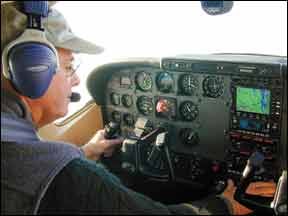Your 45th birthday is a memory. You caught yourself squinting at the gauges on a recent approach to minimums. The near-vision test on your last medical? You passed it-barely. You have presbyopia, or old eyes. This term probably made sense 120 years ago, when 40 was old, but the term persists. Its the result of the loss of elasticity in the crystalline lens in the eye, which allows us to zoom focus on near objects. Because its the lens getting stiffer, not the focusing muscles getting weak, no amount of exercise will resolve the problem. The problem gets worse with age, no matter what you do.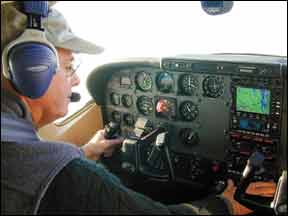
Progressive Thinking
To better understand your options for progressive lenes, take a look at your vision in general. If youre nearsighted and wearing distance-only glasses, you may have excellent near vision without your glasses and be more comfortable without glasses for reading than with progressives. That works fine at home, but not in the cockpit, so progressives are still a necessity.
If youre a pilot who wears contacts for distance and has difficulty reading, your options are limited. Bifocal contacts don’t give the acuity you need, and monovision (one eye for distance and one for near) is not allowed by the FAA. You must use either single-vision reading glasses over the contacts or progressives over the contacts. In these cases, you may simply be better off using progressive lenses alone for flying.
Have you had LASIK or cataract surgery? Custom digital (high definition) lenses may be the best choice because these surgeries sometimes induce or fail to correct higher order aberrations. These digital aberrations are not correctable with ordinary progressives, but they are correctable with wavefront technology.
don’t hesitate to interview a prospective doctor to see if he is experienced with progressive lens designs and if he has experience with pilots. The right optometrist is the one who will best serve your needs. Be prepared with a complete history of eye care, including past prescriptions, and any current eyewear. Make careful measurements of your cockpit environment. Its important to know the distances between your face and your charts, instruments and avionics. A photo of your flight deck is useful. If you fly several aircraft, photograph and measure them all.
Knowing the distances and widths of the areas of visual demand is essential in selecting the proper lens design and power. If you habitually hold your approach plates 16 inches from your face, the progressive strength would be different than if it were 20 or 14 inches.
Tips for Different Eyes
If youve never needed glasses until you hit 40-something, and then only for reading, you’ll have some adjustment transitioning to glasses. The good news is, you don’t need glasses all the time (only when you want to see, I tell my patients) and you have the largest choice in lens designs. Make sure that you choose a frame size that will allow at least 18 mm from the fitting point to the bottom of the frame. This becomes increasingly important as you go from age, say, 42 to 58 and the reading power increases.
The adjustment for nearsighted pilots (can see better at near than in the distance) depends on how nearsighted you are, and if you have astigmatism. If your prescription is relatively low (-1.00 to -2.50) with little or no astigmatism, you have a lot of choices. Just make sure there is enough vertical room in the frame. If you are more nearsighted, say above -4.00, you want to keep the frame size smaller and use either polycarbonate or high-index plastic (high index means less lens material to accomplish the desired change in power). Rimless frames may work, but the edge thickness becomes more visible; don’t try if you are over -6.00.
If youre farsighted, again, a lot depends on the magnitude of your prescription. Luckily, you’ll adjust to progressives quickly, because you cant see we’ll without them. Up to around +2.00 in the distance, there’s little limitation. Above +3.00, frame size matters, you don’t want rimless frames at all (the center of the lens
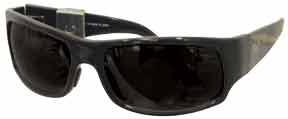
would be quite thick) and you do want polycarbonate or high-index.
Astigmatism means your eyes are not round. This is something you were born with and no amount of focusing can make a football-shaped eye see clearly. Correction has three components: sphere, cylinder and axis. The sphere is the nearsighted or farsighted component, and may even be zero. The cylinder is the magnitude of the astigmatism, and the axis is the orientation of the astigmatism (picture a football with a stick through its points so the football spins around the stick; that is the axis of the astigmatism). Your prescription will look like this: +1.00 -2.00 X 180. The sphere is +1.00 (farsighted), the cylinder is -2.00 and the axis is 180 degrees. Any cylinder greater than -2.00 is something you should discuss with your optometrist to get the best advice for your specific situation.
Anisometropia (unequal eyes) is the biggest challenge. Thickness of the lenses will be different, and in the higher prescriptions, this could cause double vision in the reading area. This is a situation you, again, should discuss in depth with your optometrist.
No matter what your condition, if any of the numbers are plus/minus 4.00 and greater, thickness becomes a consideration with respect to frame size. If you have a -7.50, you really want the smallest frame possible.
Which Lenses?
All of the several major progressive-lens manufacturers will tell you that their product is the best. Some are better than others in certain situations such as higher prescriptions or unusual frame designs (such as small vertical size or wrap sunglasses). There are also differences in price, and sometimes its worth the difference. But sometimes its not.
The largest companies include Essilor (Varilux), Signet Armorlite (Kodak), Sola (VIP), Zeiss (Individual) and Younger (Image) and Hoya (Hoyalux iD). Each one has advantages and disadvantages. For example, the Sola VIP has the largest reading area, but at the expense of the distance periphery. The Varilux Physio and Zeiss Individual are excellent high-end lenses, and the Signet Armorlite Kodak and Younger Image are all-around lenses that work we’ll in most cases.
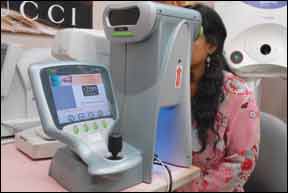
Younger recently released the Adage lens, which is supposed to be useful in cases with a smaller vertical dimension. Traditionally, 16 to 18mm is the minimum distance from the pupil to the bottom of the frame, and they claim it works with as little as 13mm. Signet Armorlite also makes the same claim for their Kodak Unique lens (I personally feel better about 18mm minimum).
There are several methods of fabricating progressive lenses today. These include traditional surfacing, digital surfacing and free-form digital surfacing. Traditional surfacing is the way the lens power has been put into the progressives since they were invented. Digital surfacing allows accuracy to 1/100th of a diopter (lens power) compared to 1/60th maximum with traditional lenses. They are fabricated using computer software to minimize aberrations and distortions inherent in the lenses. Free-form lenses are fabricated using digital technology as well, but may involve the front or back side of the lens, or both, depending on the prescription. In prescriptions over +/- 4.00 diopters, digitally surfaced, free-form lenses may have the best optics. But, of course, they are much more expensive.
A new lens technology called iZon is based upon wavefront analysis of each eye, and essentially provides high-definition vision in those of us who have higher order aberrations, or aberrations beyond simple nearsightedness, farsightedness or astigmatism, all of which are analog errors. It is the ultimate lens design for those who want the best possible acuity at any distance.
Choosing
I cant overstress the importance of confidence in your optometrist. Their guidance is the key to success with progressives. Its a team effort. The more clearly you state your expectations and demands, the more likely your optometrist can help you make the right choice.
In my opinion, you’ll get the most objective care from an independent private practice optometrist, as compared to a chain store doctor. The mass retailers have directives as to which products to choose, and will not necessarily offer every option.
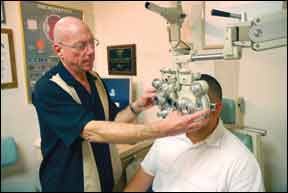
For a pilot, I always recommend anti-reflective coatings to reduce glare. This provides clearer, more comfortable vision in the cockpit, especially at night.
Sunglasses in progressive form can be either polarized or tinted. I recommend polarized for aircraft with acrylic windshields. Tempered glass creates distortions in polarized glasses, so if you fly a King Air or a Boeing 777, you need a tinted lenses. Polarized lenses may interfere with some digital displays, but only at certain angles of head tilt. I have never found that to be an issue, but you should test it with a cheap pair of polarized sunglasses before you invest.
Precise fitting is critical, and certain frame shapes and sizes work best with certain prescriptions and lens designs. Again, this is where your optometrists expertise counts. I always recommend a frame with an adjustable nose pad for progressives, simply because the frame can be micro-adjusted to ensure proper placement of the lens fitting point after the lenses have been fabricated.
There is an inherent adjustment period, but if youre having trouble tell your optometrist. A simple adjustment may fix the problem. Occasionally, there is an error in measurement or fabrication, and occasionally the lenses must be re-made in this imperfect world. Keep working with it until its right and you will be a happier, safer pilot.
In addition to being an optometrist and aircraft owner, Bob Glass is a pretty good musician. His offices are in Orange County, California.

